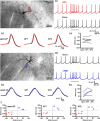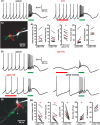Cellular mechanisms underlying burst firing in substantia nigra dopamine neurons
- PMID: 20007477
- PMCID: PMC2834564
- DOI: 10.1523/JNEUROSCI.2961-09.2009
Cellular mechanisms underlying burst firing in substantia nigra dopamine neurons
Abstract
Burst firing of substantia nigra dopamine (SN DA) neurons is believed to represent an important teaching signal that instructs synaptic plasticity and associative learning. However, the mechanisms through which synaptic excitation overcomes the limiting effects of somatic Ca(2+)-dependent K(+) current to generate burst firing are controversial. Modeling studies suggest that synaptic excitation sufficiently amplifies oscillatory dendritic Ca(2+) and Na(+) channel currents to lead to the initiation of high-frequency firing in SN DA neuron dendrites. To test this model, visually guided compartment-specific patch-clamp recording and ion channel manipulation were applied to rodent SN DA neurons in vitro. As suggested previously, the axon of SN DA neurons was typically found to originate from a large-diameter dendrite that was proximal to the soma. However, in contrast to the predictions of the model, (1) somatic current injection generated firing that was similar in frequency and form to burst firing in vivo, (2) the efficacy of glutamatergic excitation was inversely related to the distance of excitation from the axon, (3) pharmacological blockade or genetic deletion of Ca(2+) channels did not prevent high-frequency firing, (4) action potential bursts were invariably detected first at sites that were proximal to the axon, and (5) pharmacological blockade of Na(+) channels in the vicinity of the axon/soma but not dendritic excitation impaired burst firing. Together, these data suggest that SN DA neurons integrate their synaptic input in a more conventional manner than was hypothesized previously.
Figures







Similar articles
-
Calcium dynamics control K-ATP channel-mediated bursting in substantia nigra dopamine neurons: a combined experimental and modeling study.J Neurophysiol. 2018 Jan 1;119(1):84-95. doi: 10.1152/jn.00351.2017. Epub 2017 Oct 4. J Neurophysiol. 2018. PMID: 28978764 Free PMC article.
-
Synaptic activation of dendritic AMPA and NMDA receptors generates transient high-frequency firing in substantia nigra dopamine neurons in vitro.J Neurophysiol. 2007 Apr;97(4):2837-50. doi: 10.1152/jn.01157.2006. Epub 2007 Jan 24. J Neurophysiol. 2007. PMID: 17251363
-
Lower Affinity of Isradipine for L-Type Ca2+ Channels during Substantia Nigra Dopamine Neuron-Like Activity: Implications for Neuroprotection in Parkinson's Disease.J Neurosci. 2017 Jul 12;37(28):6761-6777. doi: 10.1523/JNEUROSCI.2946-16.2017. Epub 2017 Jun 7. J Neurosci. 2017. PMID: 28592699 Free PMC article.
-
GABAergic control of substantia nigra dopaminergic neurons.Prog Brain Res. 2007;160:189-208. doi: 10.1016/S0079-6123(06)60011-3. Prog Brain Res. 2007. PMID: 17499115 Review.
-
Action potential initiation and propagation: upstream influences on neurotransmission.Neuroscience. 2009 Jan 12;158(1):211-22. doi: 10.1016/j.neuroscience.2008.03.021. Epub 2008 Mar 19. Neuroscience. 2009. PMID: 18472347 Free PMC article. Review.
Cited by
-
Trpc5 deficiency causes hypoprolactinemia and altered function of oscillatory dopamine neurons in the arcuate nucleus.Proc Natl Acad Sci U S A. 2019 Jul 23;116(30):15236-15243. doi: 10.1073/pnas.1905705116. Epub 2019 Jul 8. Proc Natl Acad Sci U S A. 2019. PMID: 31285329 Free PMC article.
-
Firing pattern modulation through SK channel current increase underlies neuronal survival in an organotypic slice model of Parkinson's disease.Mol Neurobiol. 2015 Feb;51(1):424-36. doi: 10.1007/s12035-014-8728-3. Epub 2014 May 20. Mol Neurobiol. 2015. PMID: 24841382
-
Progressively disrupted somatodendritic morphology in dopamine neurons in a mouse Parkinson's model.Mov Disord. 2018 Dec;33(12):1928-1937. doi: 10.1002/mds.27541. Epub 2018 Nov 15. Mov Disord. 2018. PMID: 30440089 Free PMC article.
-
Subcellular localization of D2 receptors in the murine substantia nigra.Brain Struct Funct. 2022 Apr;227(3):925-941. doi: 10.1007/s00429-021-02432-3. Epub 2021 Dec 2. Brain Struct Funct. 2022. PMID: 34854963 Free PMC article.
-
Role of the Axon Initial Segment in the Control of Spontaneous Frequency of Nigral Dopaminergic Neurons In Vivo.J Neurosci. 2018 Jan 17;38(3):733-744. doi: 10.1523/JNEUROSCI.1432-17.2017. Epub 2017 Dec 7. J Neurosci. 2018. PMID: 29217687 Free PMC article.
References
-
- Becker C, Jick SS, Meier CR. Use of antihypertensives and the risk of Parkinson disease. Neurology. 2008;70:1438–1444. - PubMed
-
- Beckstead MJ, Grandy DK, Wickman K, Williams JT. Vesicular dopamine release elicits an inhibitory postsynaptic current in midbrain dopamine neurons. Neuron. 2004;42:939–946. - PubMed
-
- Blythe SN, Atherton JF, Bevan MD. Synaptic activation of dendritic AMPA and NMDA receptors generates transient high-frequency firing in substantia nigra dopamine neurons in vitro. J Neurophysiol. 2007;97:2837–2850. - PubMed
-
- Centonze D, Picconi B, Gubellini P, Bernardi G, Calabresi P. Dopaminergic control of synaptic plasticity in the dorsal striatum. Eur J Neurosci. 2001;13:1071–1077. - PubMed
Publication types
MeSH terms
Substances
Grants and funding
LinkOut - more resources
Full Text Sources
Research Materials
Miscellaneous
